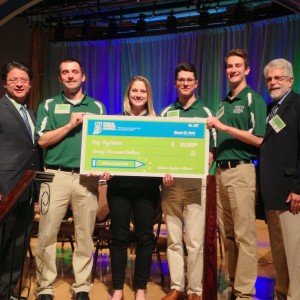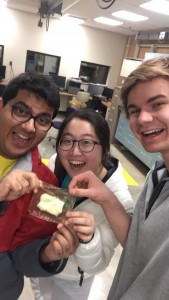ENTR Students Showcase Soy Products During Competition
At the recent Purdue University Student Soybean Product Innovation Competition, three Certificate in Entrepreneurship and Innovation students were part of winning teams.
The purpose of the Soybean Product Innovation Competition is to encourage Purdue students to exercise their knowledge and skills in creating new industrial products from soybeans.
Working in teams, with two faculty advisors, students will brainstorm product ideas, create a production timeline, conduct patent searches, develop a market analysis, document the technical process of creating their product/material, design packaging and market their product/material.

SoyFoliate team members accepted the winning prize of $20,000 for their soy based exfoliating beads. Team members are (from left) Samuel Lewis Ali Switzer, Steven Ferris and Ryan Pendegast.
Many teams entered the competition, but the top 10 competed in the final round. The top three teams win a cash prize of: $20,000 for first; $10,000 for second; and $1,500 for third.
The winning team was SoyFoliate, a soy based product used in exfoliating soaps and lotions.
Sam Lewis, SoyFoliate team member and certificate student, said one of the teammates was using a microbead containing soap and came to the realization that washing plastic down the drain can’t be good for the environment.
“We came to find that the plastic can’t be filtered out of the water and is currently polluting the Great Lakes,” Lewis said. “The fish can eat the beads, which can be fatal to the fish. If the plastic doesn’t kill them, the fish are toxic and harmful for human consumption. We believed this was a problem we could tackle with soy.”
“Soy is coarse enough to provide exfoliation, but rigid enough to retain its properties on the shelf when coated in soy oil,” Lewis said. “The product’s simplicity is the key to its success. We used whole soy beans that we milled and sieved to extract our perfect product. They were treated to increase shelf-life, but essentially the final soy bead is 100 percent soy which is biodegradable in the environment.”
Harshit Kapoor, certificate student, was part of the third place team. He said it took several months of trial and error to perfect the soy based laundry and dishwasher detergent pod, SoyPods.

Harshit Kapoor, Xuan Luo and Andrew Cameron pose with their product SoyPods. The team placed third in the Soybean Product Innovation Competition.
“In the initial stages getting the ratio of soy-protein isolate (SPI) and glycerol was a huge hurdle,” Kapoor said. “Four months of trial and error got us to the right ratio, 50-50. It was very difficult to settle on this ratio because the SPI provides strength to the film and the glycerol makes it flexible. We saw films that were hard and breakable to extremely thin and flowy to even extremely sticky ones. But through research and timely guidance from our adviser, Nathan Mosier, we developed the right balance.”
Lewis and Kapoor said the learning experiences were unmatched.
The most experiential learning opportunity was the time spent in the lab,” Kapoor said. “We didn’t have a set of instruction we had to follow. We needed to come up with our own procedure based on our research. That was the most challenging part for our team, since none of the members worked in a research lab setting before.”
Lewis added that he and his team members learned the trial and error process of developing a product and learning the market around it. They also learned that nothing goes as planned and how to embrace the changes as ingenuity.
SoyFoliate team members are Lewis and Steven Ferris, pharmacy and certificate in entrepreneurship and innovation, Ali Switzer, pharmacy, and Ryan Pendegast, mechanical engineering.
SoyPods team members are Kapoor, civil engineering and certificate in entrepreneurship and innovation, Xuan Luo, agricultural and biological engineering, and Andrew Cameron, chemical engineering.
The competition was sponsored by the Indiana Soybean Alliance.
Writer: Sayde Uerkwitz, suerkwit@purdue.edu
Sources: Sam Lewis, lewis102@purdue.edu
Harshit Kapoor, hkapoor@purdue.edu